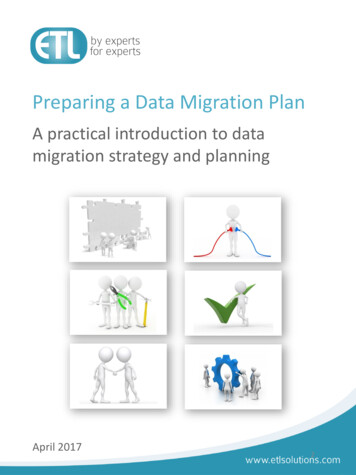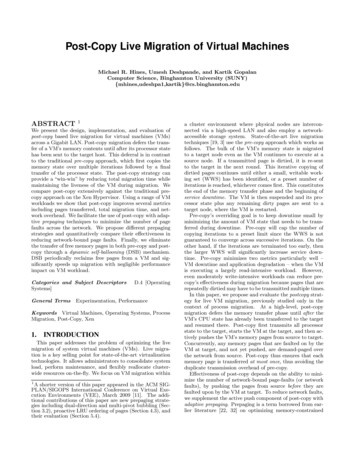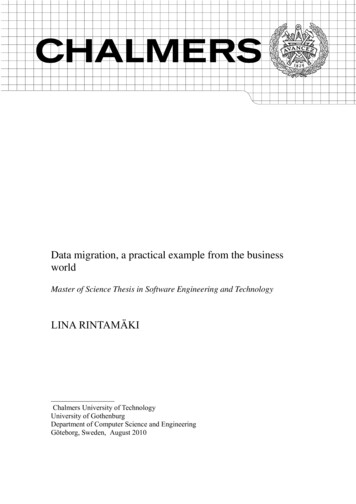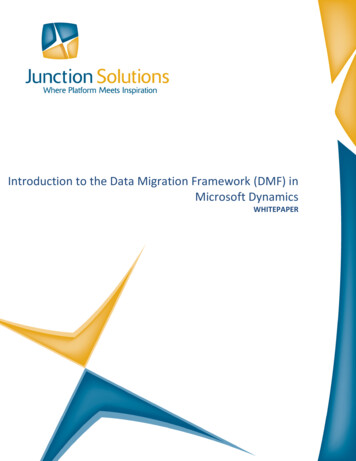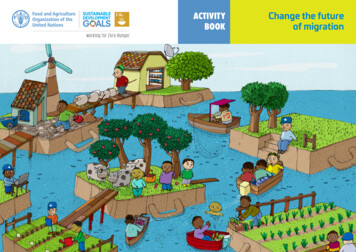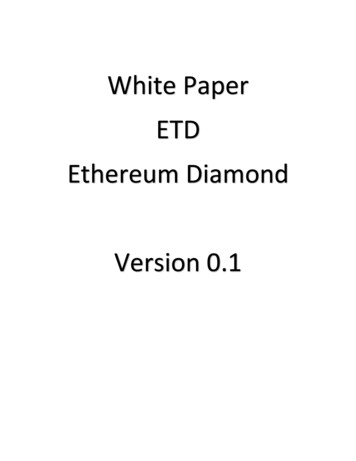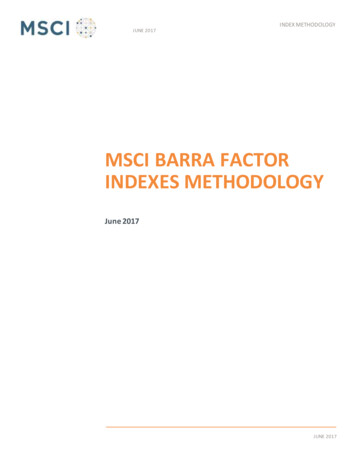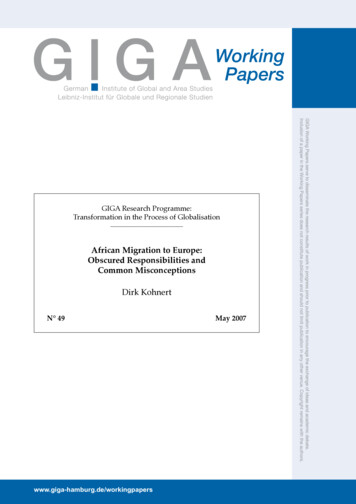
Transcription
GIGA Research Programme:Transformation in the Process of GlobalisationAfrican Migration to Europe:Obscured Responsibilities andCommon MisconceptionsDirk KohnertN 49www.giga-hamburg.de/workingpapersMay 2007
GIGA WP 49/2007GIGA Working PapersEdited by GIGA German Institute of Global and Area Studies / Leibniz‐Institut für Globaleund Regionale Studien.The Working Paper Series serves to disseminate the research results of work in progressprior to publication to encourage the exchange of ideas and academic debate. An objectiveof the series is to get the findings out quickly, even if the presentations are less than fullypolished. Inclusion of a paper in the Working Paper Series does not constitute publicationand should not limit publication in any other venue. Copyright remains with the authors.When Working Papers are eventually accepted by or published in a journal or book, thecorrect citation reference and, if possible, the corresponding link will then be included inthe Working Papers website at:www.giga‐hamburg.de/workingpapers.GIGA research unit responsible for this issue: Research Programme 3 ‘Transformation inthe Process of Globalisation’Editor of the GIGA Working Paper Series: Bert Hoffmann hoffmann@giga‐hamburg.de Copyright for this issue: Dirk KohnertEditorial assistant and production: Silvia Bücke and Verena KohlerAll GIGA Working Papers are available online and free of charge at the website:www.giga‐hamburg.de/workingpapers. Working Papers can also be ordered in print. Forproduction and mailing a cover fee of 5 is charged. For orders or any requests pleasecontact:E‐mail: workingpapers@giga‐hamburg.dePhone: 49 (0)40 ‐ 428 25 548GIGA German Institute of Global and Area Studies /Leibniz‐Institut für Globale und Regionale StudienNeuer Jungfernstieg 2120354 HamburgGermanyE‐mail: info@giga‐hamburg.deWebsite: www.giga‐hamburg.de
GIGA WP 49/2007African Migration to Europe:Obscured Responsibilities and Common MisconceptionsAbstractThe number of migrants from conflict regions in Africa has been increasing dramatically.The European Union shares dual responsibility for the continuing migration pressure:First, because it fostered over decades corrupt and autocratic regimes with dire disregardto principles of ‘good governance’. The aftermath of these regimes is still felt today andconstitutes one of the underlying factors for politically motivated migration. Second, theEU contributed to Africa’s economic misery due to its selfish external trade policy. Never‐theless, the prevailing perspective of the EU and of its member countries concerning Afri‐can immigration remains to be focused on security, the foreclosure of its external bor‐ders and prevention. Current EU programs and concepts to fight African migration arequestionable. Even development‐oriented approaches are bound to fail, if not backed bysustainable immigration policies.JEL classification:Key words:F22, F35, F42, F53, N17, N37, N44, O15, O2, O52, O55, R23Migration; West Africa; Europe; remittances; brain‐drain; foreign trade pol‐icy; security; circular migration.Dr. Dirk Kohnerteconomist, is Deputy Director of the Institute of African Affairs (IAA) at GIGA GermanInstitute of Global and Area Studies in Hamburg, Germany, and managing editor of thescholarly journal ‘Afrika Spectrum’ since 1991.Contact: kohnert@giga‐hamburg.de, website: http://staff.giga‐hamburg.de/kohnert.
ZusammenfassungAfrikanische Migration nach Europa: Vernachlässigte Verantwortung und inadäquateLösungskonzepteDie Zahl der Migranten aus den Krisenregionen Afrikas hat in den letzten Jahrzehntendramatisch zugenommen. Die Europäische Union trägt eine zweifache Verantwortung fürden zunehmenden Migrationsdruck. Erstens hat sie über Jahrzehnte korrupte und auto‐kratische Regime ohne Rücksicht auf die Prinzipien „guter Regierungsführung“ gefördert.Die Auswirkungen dieser Regime sind in Afrika heute noch spürbar; sie bilden einen we‐sentlichen Faktor politisch motivierter Emigration. Zweitens hat die EU durch ihre eigen‐nützige Außenwirtschaftspolitik effektiv zur desolaten Wirtschaftslage in den afrikani‐schen Herkunftsländern beigetragen. Trotzdem bleibt die vorherrschende Perspektive derEU und ihrer Mitgliedsstaaten auf das Problem der Sicherheit, die Abschottung der Au‐ßengrenzen und Prävention fixiert. Die laufenden EU‐Programme zur Bekämpfung afri‐kanischer Migration sind konzeptionell fragwürdig. Selbst entwicklungsorientierte Ansät‐ze laufen Gefahr fehlzuschlagen, wenn sie nicht durch eine nachhaltige Einwande‐rungspolitik unterstützt werden.
African Migration to Europe:Obscured Responsibilities andCommon MisconceptionsDirk KohnertArticle Outline1. Introduction2. Incidence of West African Migration to Europe3. Ambiguous Impact of Migration on African Economies4. Migration Routes from Africa to Europe5. Unfair EU Foreign Trade Policy Reinforces Migration Pressure in Africa6. Contested EU Measures to Prevent Irregular African Migration to Europe7. Conclusion1.IntroductionAfrica’s economic history is a history of large population movements driven by a variety ofreasons: notably, slave‐trade and colonialism, violent conflicts, poverty, ecological degrada‐tion, population pressure and a certain cultural propensity of some ethnic groups for out‐ward orientation1. Still up today, most of the 680 million Africans live under conditions ofextreme poverty and insecurity. Although the incidence of trans‐national migration re‐mained about the same on a global scale since the 19th century, its structure and directionchanged significantly2. Whereas Europe was known as source of waves of large scale out‐migration up to the early 20th century, trends were reversed after World War II. The rate ofimmigration in highly industrialized Western European countries has accelerated signifi‐12Cf. Adepoju 2003; Bilger et al. 2005; Baker et al. 1995; De Bruijn et al. 2001.Cf. Haas 2005:1270.
Dirk Kohnert: African Migration to Europe6cantly in the past decades. Mostly undocumented Africans constitute a growing proportionof these immigrants. There are well founded reasons to belief that this tendency will acceler‐ate, as Sub‐Saharan Africa has probably a higher potential for immigration into the EU thanany other region of the World.All of the twenty least developed countries (LLDCs) are African, and more than half of thembelong to crisis torn Western Africa, which in the 1990s gained the doubtful reputation ofdegenerating into the Pandora box of the continent3, situated relatively close to West Euro‐pean borders. Some experts even belief that population movements from Africa couldevolve into one of the largest in world history in the medium and long run4. Therefore, poli‐ticians of all sides concerned are well advised to take this development more serious than inthe past.However, experts and politicians alike are deeply divided over responsibilities and the bestconcepts for analysing or for solving the problem. Even in scholarly literature, several mythsabout underlying factors and structures of African migration persist5. The following pagesare meant to clarify some of the conceptual controversies of the current debate and to pro‐vide more facts and figures for decision making. A brief analysis of both, current trends inAfrican migration to Europe as well as major factors that triggered it, constitutes the basisfor a critical review of prevalent concepts to tackle the problem, notably the discussion ofdifferent aspects of the European Commissionʹs ‘Global Approach on Migration’ and of therevival of fashionable concepts of ‘circular migration’.2.Incidence of West African Migration to Europe6.Migration from Africa is a reflection of its socio‐economic dynamics over time In the pastdecades the number of refugees from conflict regions in Africa increased dramatically. Be‐tween 1993 and 2002, the population of 27 out of 53 African states suffered from violent con‐flicts. At the end of 2005 some 18% of all African migrants were refugees. This proportion isfar above the global average, as African refugees constitute about one third of the globalrefugee population. This may explain, why nearly half (47%) of the 16.7m. cross‐border mi‐grants in Africa in 2005 were women and children7. Above figures explicitly disregard some13m. additional internally displaced people, as well as a considerable number of seasonal34567Cf. Kaplan 1994.Cf. Sandell 2005:1; UN 2006a:1.Cf. Haas, 2005.Cf. IOM 2003:220.Cf. IOM 2005:33.
Dirk Kohnert: African Migration to Europe7migrants, who would have accentuated the problem even more. But even most of the trans‐national migrants remain in neighbouring African countries, overwhelmingly (42%) inWestern Africa.Apart from push factors, like violent conflicts, gross human rights violations, populationpressure, degradation of natural resources, and poverty, the major part of current migrationis due to external pull factors.Notably young people, threatened by unemployment and lack of perspectives in their homecountry, are eager to try their luck in what may appear to them at first sight as their El Do‐rado, i. e. Western Europe. Many of them struggle to reach it, in utter disregard of the in‐volved risks, by all means, mostly illegally. But let there be no misunderstanding, the ex‐treme African poor do not even dispose of this alternative, as migration to overseas destina‐tions involves considerable cost, which can be covered in many cases only with contribu‐tions by the extended family (e. g. 800 to 1,200 per person for the transit from the Senegal‐ese coast to the Canary Islands), good health condition, a minimum amount of risk toler‐ance, and embedded ness in viable trans‐national social networks.Most African migrants with overseas destinations live in Europe. According to 2005 esti‐mates of the International Organization on Migration (IOM), there are about 4.6m. recordedAfricans living in the EU, compared with 890,000 in the USA. The major reasons for this un‐equal distribution are the comparative advantages with relation to transfer cost, and the es‐tablished cultural and socio‐economic links of African Diasporas to the former colonialpowers, England, France, Portugal, Spain, Germany and Italy. According to IOM‐censusfigures about two‐thirds of Africans in Europe are from Northern Africa (Algeria, Moroccoand Tunisia). A smaller, but steadily increasing part arrived from Sub‐Saharan Africa (SSA).The latter overwhelmingly stay in France (274,538) and England (249,720), and, on a smallerscale, in Germany (154,564) and Italy (137,780)8. However, these figures are probably grosslyunderestimated, as they do not take account of the majority of unauthorized Africans livingin the EU.According to estimates of the Migration Policy Institute, there are some seven to eight mil‐lion irregular African immigrants living in the EU, mostly in its Southern parts. The actualnumber fluctuates in accordance with the regularisation programs of member states, notablyof France, and more recently of Italy and Spain. However, many of the officially recognizedmigrants fall back into illegality when their limited visas expire or if they fail to meet otherconditions for recognizing their legal status9.89Cf. IOM 2005:26.Cf. Papademetriou 2005.
Dirk Kohnert: African Migration to Europe8West Africans constitute by far the largest share of SSA‐migrants in Europe. They camemostly from Ghana, Nigeria and Senegal (see figure 1). In general, Francophone Africans aremore likely to migrate to France because of its special socio‐cultural post‐colonial relationswith its former colonies and due to the language problem, whereas Anglophone Africans,notably Ghanaians and Nigerians showed more flexibility in selecting their destination10.Figure 1:Breakdown of Major Sub‐Saharan African Diasporas in the EUSomalia/UK 8%Cape Verde/Portugal7%Nigeria/UK 7%All others 49%Ghana/UK 5%Ghana/Italy 3%Senegal/Italy 5%Senegal/France 7%Mali/France 6%Ghana/Germany 3%Source:UN 2006a: 6; IOM 2003:21911.However, the attraction of the EU for SSA migrants increases from year to year. Accordingto IOM estimates, between 65,000 and 80,000 migrants crossed the Sahara annually in theirstrive for unrecorded entry into the EU12 in the past five years. One of their major transitcountries was Morocco which recorded a tenfold increase of SSA migrants between 2000and 2005 13. Subsequently the authorities in Rabat, assisted by the EU, reinforced their bor‐ders, surrounding the Spanish enclaves of Melilla and Ceuta, as well as along the Atlanticcoast, which contributed to the recent reorientation of the flow of migration14.1011121314Cf. UN 2006a:6.Available data on migration stock mostly date from 2000 and 2001 and do not necessarily includeunauthorized migrants; therefore, they may not represent the current reality.IOM 2005:42.Cf. Reuters, Nov. 10, 2005.Cf. below.
Dirk Kohnert: African Migration to Europe3.9Ambiguous Impact of Migration on African EconomiesMigration is not necessarily a zero‐sum game, where one side losses to the benefit of others;this holds for Africa too. In the ideal case, all parties involved could gain: the migrants, theirextended families at home, the countries of origin and the receiving countries, if migrationwould be properly managed in the overall interest15. Unfortunately, selfish interest of majorplayers involved in this game, both on an individual and state level, have hitherto preventedsuch an optimal solution. Deterrence and zero‐migration policies on the part of the fortressEurope for example, encourage irregular immigration, smuggling, marginalization and ex‐ploitation of migrants on different levels and stages of their journey to Europe16.As usual, the better educated, have most to gain, and because of their resource endowmentthey are more prone than others to benefit from the pull factors, like better living and eco‐nomic conditions in their host countries. This is one of the reasons of a considerable ‘braindrain’ over the past thirty years, which resulted in the loss of about one third of the Africanacademic work force to highly industrialised countries. Between 33% and 55% of Africanswith higher education left Angola, Burundi, Ghana, Kenya, Mauritius, Mozambique, Nige‐ria, Sierra Leone, Uganda and Tanzania in search for a better life and employment in OECDcountries. For example, about 20,000 Nigerian and 12,000 South‐African doctors migratedoverseas, whereas only 33,000 remained in South Africa according to recent WHO statistics.Even the 926 Ghanaian doctors practising nowadays in OECD countries, would be urgentlyneeded at home, where they would represent 29% of all doctors employed17. Again, WesternAfrica has been the most important source of this brain drain, due to the economic and/orpolitical crisis in Ghana, Gambia, Nigeria, Liberia and Sierra Leone since the 1980s (see table 1)18.The drain of human capital is most pronounced in the employment sector for highly quali‐fied personnel (see table 1)19. Notably island economies, like Cape Verde (69%), Seychelles(59%), Mauritius (48%), Madagascar (36%), but also countries suffering from civil war, likeSomalia (59%), Sierra Leone (41%) or Liberia (37%) have been affected20. Another remarkabletrend is the ‘feminization’ of the brain drain in recent years, caused by the growing numberof highly skilled African women looking for employment abroad21. In addition, the migra‐tion of highly qualified personnel is a considerable financial burden for the state budget ofthe countries concerned. According to UNCTAD estimates the loss of one qualified aca‐15161718192021Cf. UN 2006a:1.Cf. below.ECA 2006:xvi.IOM 2003:216.26.7% in West Africa in 2000ble 1.ECA 2006:30.Cf. IOM 2003:215.
Dirk Kohnert: African Migration to Europe10demic costs on average US 184,000. Last, but not least, the brain drain delays the growth ofan African middle class and the development of sustainable structures of the civil society,which may exert a negative impact on the political and economic stability of the countries oforigin.Table 1: Immigration Rate and Level of Skill of Africans in OECD‐countries (25 years; in% of Local Work Force)Western AfricaEastern AfricaCentral AfricaNorthern AfricaSouthern AfricaLow0.30.20.52.20.11990Level of 0.50.40.62.40.5Low0.30.20.42.30.32000Level of l0.80.60.82.50.9Notes:Low skilled primary education 0‐8 years of schoolingMedium skilled secondary education 9‐12 years of schoolingHigh skilled tertiary education 13 years of schoolingSources: ECA 2006: 29; Docquier/Marfouk 2004.However, there are also positive – although often neglected – socio‐structural effects of thebrain drain, beyond the question of remittances which will be discussed further below. Thiscounteracting ‘brain gain” relates to the transfer of knowledge, of innovations and the con‐solidation or extension of foreign trade relations. New value systems, political and spiritualorientations, acquired by migrants in Europe, and imported into their home countries oftencontributed significantly to the development of Africa22. Migrants among the African politi‐cal elite for example, mostly educated at European universities, played a decisive role inmany liberation movements.Heroes of African independence, like Léopold Sédar Senghor, Kwame Nkrumah, AmilcarCabral, Frantz Fanon, or the many exiled politicians of the ANC, which contributed to theend of apartheid in South Africa, are vivid examples.In addition, remittances of African migrants can contribute considerably not just to the well‐being of their families at home, but to poverty reduction and development on a regional oreven national level in general23. Case studies from Burkina Faso for example revealed thatremittances of migrants reduced the rate of households living below the poverty line by 7.2%24.Although average individual remittances from Africans are relatively low (US 200‐300), com‐222324Cf. Haas 2005:1272‐73.Cf. OECD 2006:142‐43; Gubert 2005; Sall 2005; Haas 2005: 1274‐78.Cf. ECA 2006.
Dirk Kohnert: African Migration to Europe11pared with the global average, its overall annual total doubled between 2000 and 2005 from 4.9to 8.1bn. US , according to estimates of the World Bank and ECA. All officially recorded trans‐fers of migrants from Africa amounted to 14bn. US in 2004. Depending on the respective coun‐try, this represented, from 3% (Nigeria, Kenya), 7% (Ethiopia, Senegal, Sudan), 11% (Ghana),23% (Cape Verde), up to 40% (Lesotho) of Gross Domestic Product (GDP)25. Remittances via of‐ficial channels accounted for over 200 billion CFA (300 million Euros) for Senegal only26.However, these official figures reflect only an incomplete image of the reality. Many Afri‐cans prefer informal channels for remittances’ transactions in view of the lack of perform‐ance of the African banking system, notably if they are unauthorized guests in their receiv‐ing country. These informal transfers amount to two to threefold of the share of officially re‐corded remittances, according to estimates of the IOM. In some LLDCs they surpass evenprivate foreign direct investments (FDI) or development aid (see figure 2).Figure 2: Financial Inflows of ODA, FDI, and Official Remittances(average of the years 1980 to 1999)100%80%60%FDIODA40%remittances20%0%Togo CameroonSenegalSource:MaliBurkina BeninFasoNigeriaCape Tunesia Egypt MoroccoVerdeIOM 2003: 228, World Bank data of 2001Therefore, it has been recognized that remittances (mostly from Europe) constitute the sec‐ond largest source of external private finance in African developing countries, besides FDI.Up to now they are an underutilized and badly managed source of national development inthe countries of origin27. However, the EU member countries bear their share of responsibil‐ity too: high entry barriers, and the criminalisation of irregular immigrants, result in socialseclusion and formation of ghettos of migrants in European capitals, which discourage re‐252627OECD, 2006:142‐143; cf. ECA 2006:75‐76.UN 2006:19.Cf. Ionescu 2006; Adams et al 2005:1645.
Dirk Kohnert: African Migration to Europe12mittances because the concerned prefer to care for their immediate own needs in an hostilesocial and political environment28.4.Migration Routes from Africa to EuropeIn the last two decades Northern Africa developed into a transit region for Sub‐Saharan mi‐grants. The new migration pattern, its policy response by the Maghreb‐ and European states,as well as its negative ‘side effects’ on the migrants concerned, have been analysed in detailby Baldwin‐Edwards (2006) and others29. The actual number of Sub‐Saharan migrants living‘in transit’ in Northern Africa is difficult to estimate. Most of them are irregulars, ‘withoutpapers’, mostly living as outcasts under miserable conditions, in an Arabic xenophobic so‐cial environment. A case study of irregular African migrants living in Algiers revealed thatabout two third of the interviewed migrants considered themselves treated as ‘slaves’, ‘poorwretches’, or subhuman beings30. According to well‐informed estimates, there are at least100,000 living in Algeria and Mauritania, more than a million in Libya, and some ten thou‐sands in Morocco. They are certainly not welcomed by the local population and the authori‐ties. Between January 2000 and the March 2006 about 35,000 unauthorised Sub‐Saharan mi‐grants were forcibly expulsed by Algerian authorities (ibid).Because of more rigid migration controls of EU member states, the sealing off of its Southernborders and of the costal line between Morocco and Mauritania against the increasing influxof irregular migrants, migration routes shifted increasingly to sea‐born alternatives, notablyfrom Senegal, Gambia and Guinea to the Spanish Canary Islands (see graph 1)31. The latterregistered over 31,000 African refugees in 2006, a sixfold increase compared with 2005, andalmost four times as many as in the previous four years combined32. Additional 5,000 hadbeen intercepted by the islands’ coastguards, and 6,000 migrants died or went missing onthe perilous 1,000 km sea journey under appalling conditions, according to estimates ofSpanish border authorities in Tenerife33. Another 16,000 African migrants arrived on the tinyItalian island of Lampedusa (south of Malta) from the Libyan coast in the same year.As for the Atlantic sea routes, migrants pay the smugglers between US 800 and 1,250 for aone way passage from Senegal to the Canary Islands in customary small wooden fishing282930313233Cf. Haas 2005:1278.Cf. Boubakri 2004, Fall 2004; Haas 2005a; Hamood 2006; ICMPD 2004; Marfaing 2004.Cf. Simon, C. (2006): Le Maghreb, espace d’immigration. Le Monde, December 15, 2006.Cf. Parkes 2006.Cf. BBC‐news Africa: Canaries migrant death toll soars. December 28, 2006.Cf. below in more detail.
Dirk Kohnert: African Migration to Europe13boats, called lothios, or ‘pirogues of death’ in local dialect34. Because of the rapid growingdemand, boat‐builders and carpenters in Gambia started to construct bigger pirogues, espe‐cially designated for the transport of 60 to 100 migrants, which cost about 100,000 dalasi(US 3,539). They are equipped with two outboard engines, GPS, and a minimum of petroland other supplies for the eight to twelve day journey, depending on the sea conditions. Thetransfer in the crowded boats under the open sun is life threatening. Local agents openlyadmit that the chances the boat will be detected by border patrols before arrival or simplyperish at sea, is 50:5035. No wonder then that experienced pilots of these pirogues are in highdemand. One renowned ‘pirogier’ was the ‘Baron’ from Saint‐Louis, who escaped prosecu‐tion in Senegal in September 2006 by fleeing to Mauritania. He was said to have successfullytransported over 1,000 migrants to Tenerife36.Graph 1:Source:343536Migration‐routes from Africa to Europe UN 2006a:12.Cayucos, in Spanish.Cf. Fleming, L.: Gambia – new front in migrant trade (BBC‐Africa news, October 10, 2006).Cf. Belleret, R.: Chronique des clandestins (12) – On n’arrêt pas la mer avec les bras (Le Monde, Oc‐tobre 22, 2006).
14Dirk Kohnert: African Migration to EuropeConcerning the risk evaluation of such journeys, the long distance over the open Atlantic isnot the only problem. Senegalese fishermen were already forced before to travel along theWest African coast up to the Golf of Guinea in search of valuable catches, because their localfishing grounds had been depleted by foreign (mostly EU) fishing armadas37. The new GPStechnique facilitates orientation38. Besides irresponsible neglect of basic security precautionson the side of the smugglers, the major cause for imminent danger lies in the special frame‐work conditions for these transports, i.e. clandestine refugee‐transfers in overcrowded boatson the high sea, enforced by the close surveillance of the multinational Frontex sea‐ and airborn forces39, patrolling along the West African coast, organized by the EU and concernedAfrican states. This was demonstrated by the sad fate of a tiny rickety yacht which started atChristmas 2005 with 37 Senegalese migrants on board, towed by a bigger smuggling vesselwith destination to the Canaries. On the way, the smugglers severed the towing line, possi‐bly, because they feared detection by the coastguard planes, and the yacht drifted into theopen Atlantic. On April 30, 2006 fishermen from Barbados, rescued the boat, driven by thetrade winds over the Atlantic, but nobody had survived the ordeal; they found only elevenmummified corpses and some evidence of their origin and fate on board40.Notwithstanding these imminent hazards, the desperate migrants see no alternative. Appar‐ently, even Asian smugglers joined already the lucrative business. They transport migrantsfrom Pakistan, India or Bangladesh by air to West African harbours where they are loadedon board of unseaworthy ships meant to reach the Canaries. In September 2006, a rusty fishtrawler with 160 Pakistani and Indians on board was intercepted by the Spanish coastguardbefore the Canaries. In February 2007 a fish trawler, overloaded with some 400 migrantsfrom Kashmir and different African origins, set sail from Guinea to the Canary Islands andbroke down in international waters off the Mauritanian coast. It was towed, after one weekof wrangling over the responsibility for the rescue mission, to the Mauritian port ofNouadhibou for the repatriation of the migrants41. Most of the irregular migrants whose na‐tionality could be identified were repatriated to their home countries. Thus, on the base of a3738394041Cf. below.Belleret, R. (2006a): Chronique des clandestins (10) – L’irrésistible appel du large (Le Monde, Oc‐tobre 20, 2006).‘Frontex’, the European Agency for the Management of Operational Cooperation at the ExternalBorders of the Member States of the European Union, was established in 2004. In 2006 it preventedsome 4,000 African migrants to reach the Canary Islands (cf. BBC‐news Africa, January 26, 2007).Cf. Nation News, Barbados, May 7, 2006. Connotations with the deplorable conditions of the Atlan‐tic slave trade are not too far fetched.Cf. dpa, September 15, 2006; UN 2006a: 12; BBC‐news Africa: ‘Mauritania to let migrants land’.February 10, 2007; UN‐news Service: ‘West Africa: UN Refugee Agency Calls for 400 People Adriftto Be Allowed to Disembark’. February 9, 2007.
Dirk Kohnert: African Migration to Europe15bilateral agreement between the Spanish and Senegalese immigration Authorities 4,400 mi‐grants, interned in refugee camps on the Canary Islands, were repatriated by plane to SaintLouis (Northern Senegal) between September 9 and October 26, 2006.5.Unfair EU Foreign Trade Policy Reinforces Migration Pressure in AfricaThe enduring desolate economic situation and bleak perspectives of most households in Af‐rican LLDCs account for one of the major reasons for African trans‐national migration. Thishas been recognized by the member states of the EU too. At the joint EU‐AU migrationsummit in Tripoli (November 22 to 23, 2006) they promised to stem the growing flow of mi‐grants, among others by a significant increase in development aid to the most affected West‐and North African countries, specifically targeted on potential migrant populations. In total,the EU promised to allocate some 40m. to boost job creation in Africa42.However, aid and development do not necessarily lead to a reduction of migration. On thecontrary, different studies suggest that at least the kind of economic growth promoted bythe highly industrialized Western countries and by the WTO, based on a neo‐liberal ap‐proach of trade liberalization, would stimulate migration from Sub‐Saharan Africa in themedium and long run43. This applies the more, if the donor countries obstruct sustainablegrowth of African LDCs by non‐tariff barriers to trade, unfair subsidies and dumping priceswhich undercut the comparative advantages of these countries for labour intensive agricul‐44tural products in the world market . Thus, studies published by the World Bank, interna‐tional NGOs, and others repeatedly blamed the EU in this respect, proving that the EU for‐eign trade policy contributes to a significant extent to reduce the income‐earning possibili‐ties of West African producers, in pursuit of the commercial interest of the EU member45states, and to the detriment of development in Sub‐Saharan Africa . In addition, this selfishforeign trade policy of the EU and its member states counteracted its own pro‐poor devel‐opment cooperation with African states which it tried to implement since decades. The mostblatant examples are the EU fisheries and agricultural policies, the negative effects of which46have been discussed in more detail elsewhere . Just the elimination of unfair cotton subsi‐dies paid by the USA, China and the EU to their farmers would increase the income of WestAfrican cotton producers by
African Migration to Europe: Obscured Responsibilities and Common Misconceptions Dirk Kohnert Article Outline 1. Introduction 2. Incidence of West African Migration to Europe

